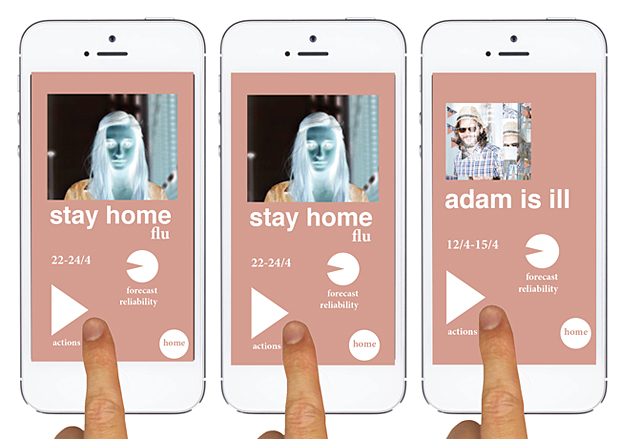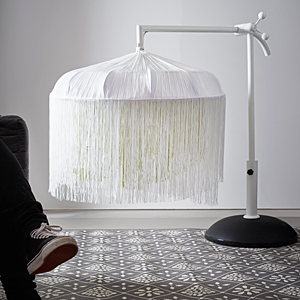The future of digital gadgetry
When the Mobile Life research center hosts an open house, there's joy and playfulness. Here's a glimpse of some of the ways the Internet of Things could become part of our lives in the near future.

How to make a control room in a nuclear plant more entertaining? How can future furniture look and function? Is it possible to create a mobile app that tells you when you are going to get sick? Scientists at Mobile Life are coming up with the answers.
KTH is a major partner in Mobile Life center, which is led KTH Professor Kristina "Kia" Höök. Here is a delightful jumble of robots and self-made innovations. If you ever feel that creativity is on the way out, this is where you should go for some inspiration.
"A large part of the Mobile Life research is basic and ideas and thoughts here reach the market in about eight to 10 years," Höök says. "There are many different disciplines and areas represented and play and creativity are at the center."
She goes on to say that the center, which has now been in existence for seven years, is home to 45 researchers. The research itself is cross-border and mixes such diverse areas and topics as computer science, interaction design, materials science, sociology and psychology, fashion, sports, game design and dance.
In one corner is Johanna Mercurio working with some furniture prototypes that she and her colleague Martin Jonsson developed in close cooperation with IKEA.

After a long, hard day, sometimes you just want to craw into a cocoon — that is, if you had one. Well, soon that might be possible.
Mercurio and Jonsson have developed some prototype that are intended to improve awareness of your own body.
The Body Aware project has produced one piece that resembles a cocoon. You crawl inside and you are greeted with light pulses that are timed with your breath, while a pleasant warmth spreads through the ground on which you rest.
The cocoon recalls the same encircling feeling as Eero Aarnio's famous Ball Chair recliner, but is much more stimulating than that.
Body Aware is intended is to increase people's awareness of their own bodies. It's basis is the movement pedagogy of the late Israeli physicist Moshe Feldenkrais Method, that is to say, it's about sensitizing how various human body functions move in unison and influence each other. Concretely, this involves new ways to breathe and visualize all the small body movements that we do not think about.
Research colleague Oskar Juhlin also collaborated with IKEA and produced some exciting and beautiful prototypes.
In the research project Live Nature, he and his colleagues paired small weather stations with mobile phones cameras, microphones, and other sensors, making it possible to stream images, audio and other information directly to digital photo frames or the web. Why only a watercolor painting of the country, when you can have the same scene depicted in all seasons, with sound and pictures, on the wall or even on your Facebook page?
Juhlin also researches on smart watches in the project Watch for Figuracy. These watches are designed to adapt to your wardrobe. If you wear a dark suit changes its appearance accordingly. Put on a light gown and the watch changes again. It is about letting fashion and technology enter into a lifelong marriage.
Keeping up the energy

When we imagine working in a control room, it's hard not to picture Homer Simpson dozing at his desk at Springfield nuclear plant. But there's an element of truth behind every satire — working in a nuclear control room can be fatiguing, as well as stressful. That's why Jarmo Laakso invented a way to keep control room environments nice and lively.
"Those who work in a control room, such as in a nuclear power plant, need to be alert and engaged all the time. What can counter this is long periods of inactivity, due to the nature of the job in a confined workspace with little external stimulation," says Laaksolahti, a researcher at KTH Royal Institute of Technology's Mobile Life Centre.
So, with some skin sensors and bundles of light sticks, Laaksolahti, has created a light show in which each control room employee's emotional state is mirrored in color and luminescence.
Laaksolahti says the galvanic skin response (GSR) sensors measure how well the skin conducts electricity. Skin conductivity is affected by sweat, which is in turn elevated by stress.
The electro dermal activity readings activate the light sticks. Red indicates high conductance (or stress), and green means low conductance.
Laaksolahti set up several sets of light sticks - each one linked to one person in an actual control room. Then the staff had to figure out which light corresponded to which person.
"They found it really interesting as a mirror of themselves, as a reflection of what's inside rather than the outside," he says. "It also triggered many discussions about stress, the workplace, and how your co-workers are feeling, in addition to giving an overview of what kind of day the operators were having, that is, whether it's a calm one, or a stressful one."
In addition, light globes were set up to illuminate for a certain period when people are around them. The globe, he says, gives a residual sense of life and movement.
"It is not always easy for people to anticipate what they want in the future, so this stuff is a way to explore that," he says.
Anticipating the future is what researcher Vincent Lewandowski is working on with his focusing on the way the Internet of Things impacts people.
"For a long time the focus has been on smart refrigerator that keeps track of how much milk or how many eggs you have left," he says. "I want to focus instead on what things are connected to the internet in the future, and what will be the consequences."

For example, in collaboration with fashion brand Björn Borg, Lewandowski has sketched and considered the future of underwear.
Google's recent acquisition of Nest Labs for $ 3.2 billion also plays a role in Lewandowski's research. Nest Labs manufactures a smart thermostat connected to the internet which can be installed in the home — a typical Internet of Things gadget.
The Google investment indicates that this technology will be developed so that information about customers' temperature conditions at home can be monetized.
This is where personal integrity comes into play, something that Lewandowski is very interested in.
Jacob Tholander research is in the topic Internet of sports, a subset of the Internet of Things. He shows a mobile app that communicate with a band of sensors deployed around the chest. Besides pulse, it also measures movements in height and width. This information is then illustrated on the mobile screen.
"Run back and forth, and you'll see the result then," he urges. On the screen, a pattern is showing how one moves during a short jog.
Another software related to the body is Lucian Leahu's app Illbook. With the help of large amounts of data and related analysis — that is, big data — the app can predict when you will get sick. The information used (and which can be readily be collected via mobile phone) includes whom you met in recent days, if your child had symptoms of illness, and which of your colleagues have been ill. The app can also use sensors if you connect them. With enough data, it is possible to predict whether you or a colleague will be sick tomorrow.
This may be perceived as intrusive, but there are some clear advantages. You do not have to worry about canceling meetings while you vomit. And you can proactively prevent the spread of infection. The fact is that there are very many uses, when you think about it.

Vasiliki Tsaknaki, another KTH researcher who works at the Mobile Life, Is exploring the use of different materials can be used with technology, such as leather, wood and copper, as well as how to make jewelry with different functions. Tsaknaki shows a necklace that is also a complete speaker system.
Part of her research is exploring different precious metals with conductive properties in order to be able to design mobile and portable gadgets.
Tsaknaki says that she is interested in how these materials age, and what patina they acquire with use.
What can you do with IT rubbish? Turn it into poetry, of course.
Elsa Vaara developed the app DELETE by Haiku, for Android. The program simply takes the old text messages from your mobile and converts them into Japanese-style poems.
Just as interesting is the app Rhythm Poetry. Vaara considers rhythm to be an interactive material which we use all the time when we walk, talk, eat or breathe. It is everywhere.
It also enables us to use rhythm for different things. As in poetry. That's exactly what Rhythm Poetry is about. Drum, talk or sing to the app, and it gives you a poem back.
"The app gives a poetic interpretation of rhythm. It can be beautiful, ugly, expressive, reflective, and so on," she says.

